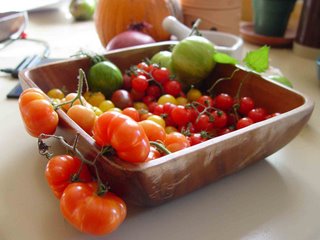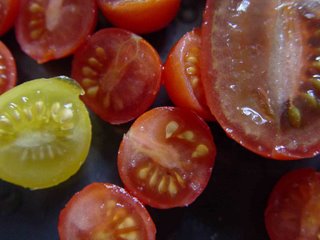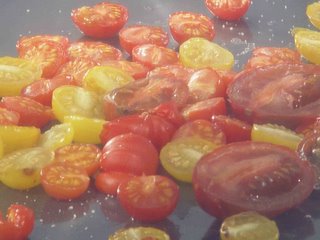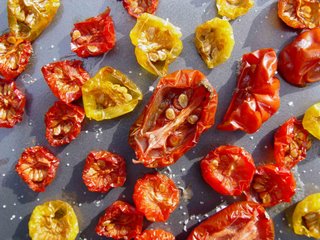Sun Baked Garlic
My father is an obsessive grower of his own garlic. This year the garden produced over 100 fat, hard bulbs packed with juicy cloves full of pungent flavours. Next year's harvest will be even bigger, and it's no wonder. Eating fresh garlic from the garden for the first time is like seeing a new colour. You never knew it could taste like that!

Those faded, desiccated, peeling and flaking garlic lumps that languish in the supermarkets this fall seem to be of a different order altogether than those magnificent, tightly packed, white spicy garlic bulbs that spring from the dense clay soil in my parent's backyard. It's not just seeming. They are much tastier. But garlic does fade with time, whoever grew it. In November, we can transform the flavours of the fresh summer garden into subtler combinations that bring their own pleasures before the fresh garlic goes too stale.
Today, on a rather average solar day with some intermittent clouds, I'm going to bake two uneaten half cloves of dad's garlic before I put them into a lasagna that I'm going to bake in the Sun Cook tomorrow. I'm using a terra cotta garlic baker my mom bought me for my birthday. To use it, simply soak the terra cotta in water for 10 minutes, then place the garlic bulb inside.
To bake a garlic, you can either split it open, or else chop the stem off to expose the tops of the cloves without cutting into them. Pour organic extra-virgin olive oil over top, being sure to coat every surface. Then douse the garlic with a bit of sea salt and fresh ground pepper to taste.
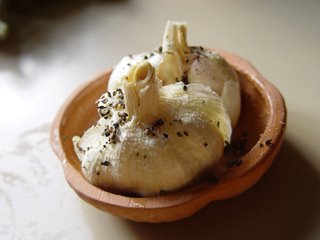
I placed my garlic into the pre-heated Sun Cook for two hours. The thermal mass of the terra cotta is relatively small, so it will not drain excess solar energy from the Sun Cook. I would avoid using denser ceramics, as the ceramic would absorb too much heat from the oven.

Baked garlic turned out lovely brown cloves with a creamy, mellow flavour, without any of the wassabi like sharpness that characterizes fresh, raw garlic cloves. The flavour of baked garlic is the perfect flavour to add depth to any pasta sauce. You can also use baked garlic paste to glaze a roasting chicken, for absolutely unforgettable results.
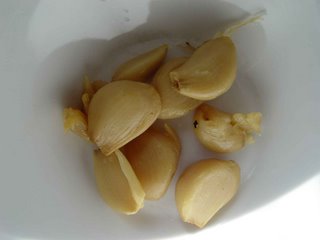

Those faded, desiccated, peeling and flaking garlic lumps that languish in the supermarkets this fall seem to be of a different order altogether than those magnificent, tightly packed, white spicy garlic bulbs that spring from the dense clay soil in my parent's backyard. It's not just seeming. They are much tastier. But garlic does fade with time, whoever grew it. In November, we can transform the flavours of the fresh summer garden into subtler combinations that bring their own pleasures before the fresh garlic goes too stale.
Today, on a rather average solar day with some intermittent clouds, I'm going to bake two uneaten half cloves of dad's garlic before I put them into a lasagna that I'm going to bake in the Sun Cook tomorrow. I'm using a terra cotta garlic baker my mom bought me for my birthday. To use it, simply soak the terra cotta in water for 10 minutes, then place the garlic bulb inside.
To bake a garlic, you can either split it open, or else chop the stem off to expose the tops of the cloves without cutting into them. Pour organic extra-virgin olive oil over top, being sure to coat every surface. Then douse the garlic with a bit of sea salt and fresh ground pepper to taste.

I placed my garlic into the pre-heated Sun Cook for two hours. The thermal mass of the terra cotta is relatively small, so it will not drain excess solar energy from the Sun Cook. I would avoid using denser ceramics, as the ceramic would absorb too much heat from the oven.

Baked garlic turned out lovely brown cloves with a creamy, mellow flavour, without any of the wassabi like sharpness that characterizes fresh, raw garlic cloves. The flavour of baked garlic is the perfect flavour to add depth to any pasta sauce. You can also use baked garlic paste to glaze a roasting chicken, for absolutely unforgettable results.

